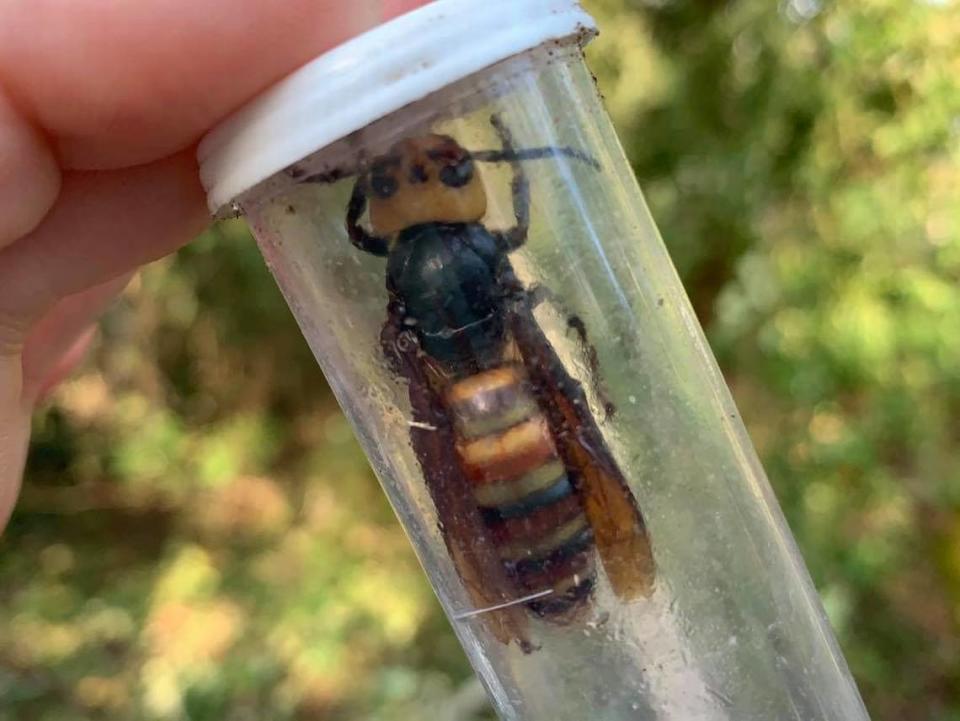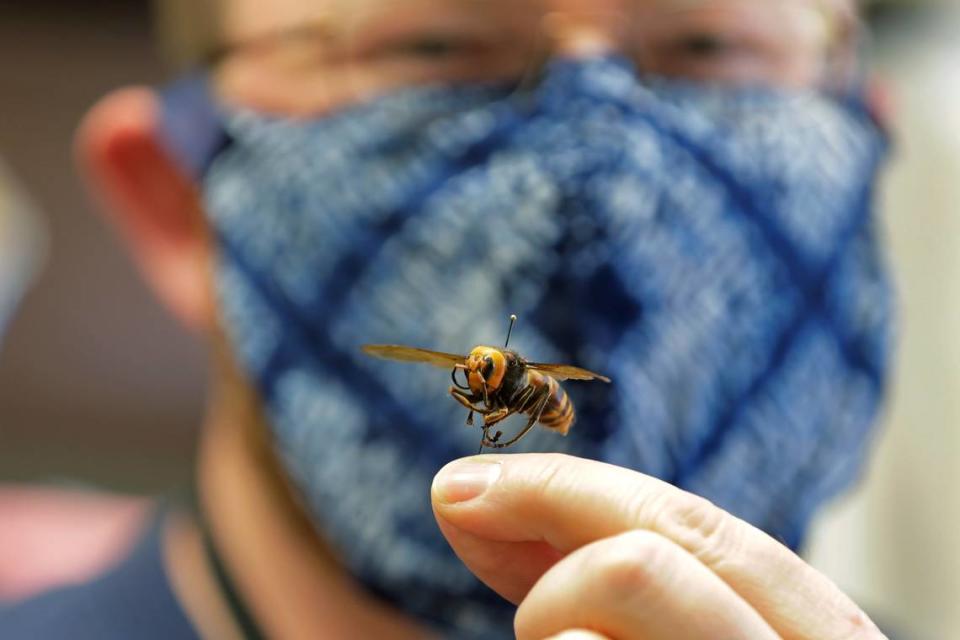Researchers confirming if first ‘murder hornet’ of 2022 has been found in Whatcom County
While the Washington State Department of Agriculture is working to confirm if the first Asian Giant Hornet of 2022 was captured in northern Whatcom County last weekend, it is also ramping up efforts for another summer of tracking, studying and eradicating the invasive species, commonly known as “murder hornets.”
Though the Department of Agriculture continued to receive reports of possible Asian giant hornet sightings throughout the year, none have been confirmed since late last summer, Department of Agriculture managing entomologist Sven Spichiger said during an online preseason briefing Tuesday, May 24.
“We have one that is fairly serious that came in over the weekend that we’re investigating that happens to be in the same area where all three nests were located last year,” Spichiger said. “So obviously that one catches our attention.
“We’re not sure what to make of it, because it was very early for the type of activity that was described, and most everything else in the insect world, including all of our trapping programs, are actually running late (due to this year’s cold, damp spring season).”
That comes after 14 Asian giant hornet specimens were captured and confirmed in 2021 and the Department of Agriculture eradicated, or destroyed, three of their nests just east of Blaine near the U.S.-Canadian border.
“We are still in a tightly compact and confined area, which leads us into this season with a bit of optimism that it has not spread to multiple counties and does not appear to be throughout the rest of Whatcom County, which is really good news,” Spichiger said.
All three nests, which were located within two square miles of each other, were found thanks to trapping efforts, including some by citizen scientists, in northern Whatcom County that led researchers to the nests.

Because of that success, Spichiger said the Department of Agriculture will continue its trapping efforts in northern Whatcom County in the hopes that they can quickly locate and eradicate any new nests that pop up in that area.
Trapping also will continue in southern portions of the county, Spichiger said, but hopes are that this might be the last summer that is required.
“Some of you might be aware that a single specimen ... was killed on a porch in Bellingham in 2020, and we will continue to trap that area until we have three years of negative finds,” Spichiger said. “This would be our third year. So as long as everything continues to go negative in Bellingham, then we will be able to dial back the trapping in that area.
“Most of the trapping will be confined adjacent to the Canadian border again in Northern Whatcom County, all the way out to Lynden and going all the way to the Puget Sound.”
Approximately 1,000 program traps will be placed in that area, Spichiger said, and the Department of Agriculture is once again encouraging residents in the area to use their own traps in the area and report any suspected sightings.

Expanding citizen scientists’ role
Those who do want to place their own traps are now asked to cut an “H”-shaped or square opening in a 64-ounce plastic bottle, like traps that were recommended in 2020, Spichiger said.
“We had some reports that folks believed hornets were escaping from those in 2020, so in 2021 we switched to a star-shaped opening and used that for a season,” Spichiger said. “But what we found is that those openings tended to close back up, and many people had to reopen them, so our fear is the hornets, if they are trying to get into an opening that has been closed, they’re not going to be able to do that.
“Throwing caution to the wind, we’re moving back to one that we know worked in 2020 certain and did not have the problems of those openings closing back up.”
The Department of Agriculture still is asking that all hornet sightings or trappings be reported via its online Hornet Watch Report Form, by emailing hornets@agr.wa.gov or calling 800-443-6684.
Spichiger said the Department of Agriculture also is excited to expand the role of citizen scientists in northern Whatcom County in 2022 with its new “Adopt a Wasp” program, asking landowners in their area who find a paper wasp nest on their property to monitor the nest from a safe distance, rather than destroy it.
“We’re asking people basically to adopt one of these on their property, report that location to WSDA in our online application and simply check back in once a week to tell us how it doing,” Spichiger said of the program, which begins June 1. “What we’ll be looking for with that is activity in the nest and also we’ll be looking to see if there is any Asian Giant Hornet activity on these paper wasp nests.
“The reason we’re moving and launching this is, in 2021, all three of our nests came from public reports where folks noticed Asian giant hornets feeding on the paper wasps in these paper wasp nests. Sure enough, this turned out to be a very valuable tool for us, and it’s pretty easy to do as long you keep your distance and you have a camera and a steady hand.”
While northern Whatcom County residents are the Department of Agriculture’s main target for the wasp program, Spichiger said they would accept the help from anywhere in the state.
More new tools
Researchers also will have a number of new tools at their disposal in their efforts to make sure Asian giant hornets do not gain more of a foothold in Whatcom County or elsewhere this year, Spichiger said.
That includes sending researchers to Japan and South Korea to work with experts in those countries to learn more about the hornets and what sorts of traps and lures work best.
“We had quite a busy year and we did quite a bit of work in 2021, but one of the things we noticed that because we were eliminating every nest we find almost immediately, it’s very difficult for us to get good information,” Spichiger said.
One of the questions Washington state researchers want to answer is how far queens can disperse during the breeding season to better understand how large an area to focus efforts once, and if, new nests are discovered.
Spichiger said those tracking live, captured Asian giant hornets also will be using drones in an effort to follow the hornets back to their nests, allowing for easier and safer GPS tracking.
The hornets, themselves, also will likely have a new, official common name before the end of the summer. Spichiger said a Department of Agriculture researcher has submitted a suggested new common name for Asian giant hornets to the Entomological Society of America, which has a committee to designate official common names for species.
Spichiger said the committee is still reviewing a possible name change — a process he said usually takes 30 to 90 days — and he would not release the possible new name until the decision is official, but said the Department of Agriculture would adopt whatever name is chosen.
Whatever they end up being called, Spichiger said he is optimistic about the progress being made against the invasive species.
“I know we’re a lot faster at tracking and finding nests,” Spichiger said. “I know we’re finding better tools for the public to help their own cause and let us know where to come to spend resources. Certainly with the ‘Adopt a Wasp’ program, to me, that is progress. We have identified a biology and a behavior that we know is going on here and we can use that to our advantage.
“That to me is progress, and to me, after what we saw with a different hornet being introduced in Europe and spreading to multiple nations within three to four years, I think we’re doing pretty good right now. We always like to be optimistic.”

